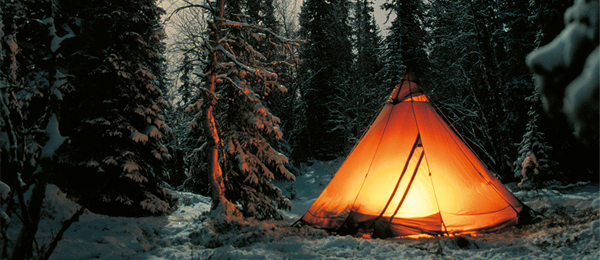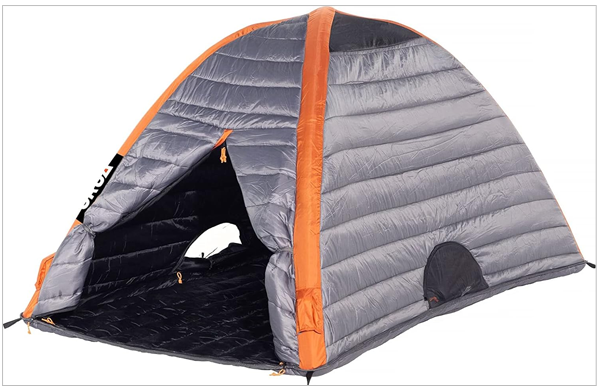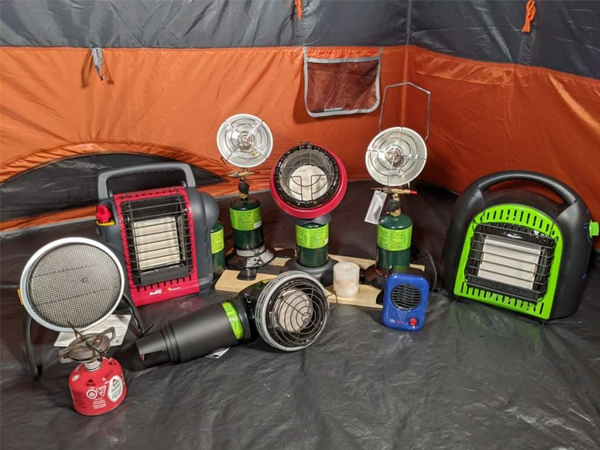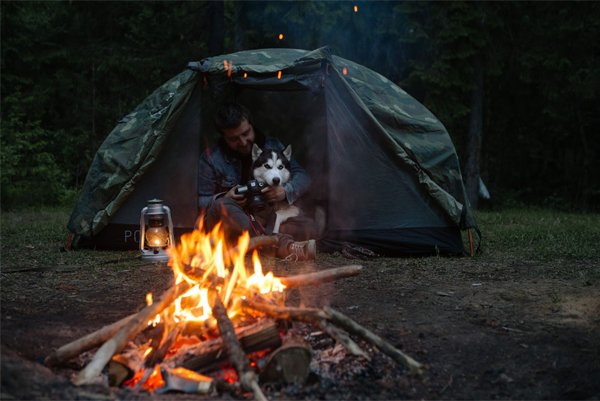Polyester is the most commonly used material for camping; polyester blankets are the best because they are durable, but thermal sleeping bags are preferred in colder climates.
9 Safe and Inexpensive Ways to Heat a Tent and Stay Warm
In cold regions, camping becomes a formidable task as the conditions are very inhospitable during the night. I have camped in a temperature below -5 °C and the most hurtful part was sleeping at night with strong cold wind flowing.
In such circumstances, especially in high-altitude areas, it is important to be well-equipped with resources to keep you and your tent warm. There are several camping pieces of equipment that you should carry with you, but considering the fact, most of them are very expensive.
So what else can be done? There are some other inexpensive options to consider for preserving heat in tents, so without further ado, let us move on to those methods.
9 Effective Methods to Preserve Heat in Tents

Trekking at such high altitudes is dangerous, where your energy drains quickly. In such conditions, you should avoid carrying heavy-weight items as it makes your journey more difficult. You should keep the essentials with you that are needed in your trek that will help you to stay warm and revitalize.
So here are some of the best ways to preserve heat in a tent with the fewest resources possible.
Spot a Perfect Campsite
A perfect campsite is one where neither the site is too open nor too dense. If the area is wide open, there is a good chance that you will experience strong winds at night. On the other hand, densely packed areas would affect the room required to build the tent and also impact the insulation of certain types of tents.
Use Insulated Tents

You can buy insulated tents, which are easily available in the market. These tents include double-wall construction, heavier materials, and reflective coatings, which are great for repelling cold wind, but also make insulated tents heavier. So consider the weight before packing and make sure you are thorough with the setup, as insulated tents have different methods compared to traditional tents.
Hot Rocks
If there are a lot of rocks in your camping location, heat them and place them in your tent. This is a scenario when natural resources may assist you, just carry some pieces over to your location and set them on a metal grid over a campfire.
Wait until they cool down enough to avoid burning your tent. Wrap each item in cloth and place it inside your tent.
Hot Water
Before you go to camp, grab a few hard plastic bottles, particularly big ones, because they hold heat for longer. If there is a lot of snow, getting water will not be an issue. Fill your pan with snow, melt it, and heat the water almost to the boiling point. Pour it into the bottles, seal them tightly, and place them inside your tent.
Carry a Heated Carpet
This is my personal favorite and the most commonly used method among campers. There are heated carpets available, so you do not have to bring your existing carpet from home. It is important to check whether there are any gaps between the floor and the walls, due to which cold winds could come in, and this method won’t work.
Heat the Ground
Simply heat the hollow ground with fire and fill it up. The technique consists of multiple steps that need a little work and patience. Simply select the location and dig the hole. Build a campfire under it and let it burn hot. Wait until the fire goes away and then fill in the hole.
This will make the ground warm and comfortable for sleeping; simply pitch your tent on top, and you are ready to go.
Hot Tent
Hot tents are those tents where you can use the stove and keep the tent warm. It has a wood-burning stove and you can do more than keep the tent warm, you can cook and keep your clothes dry as well.
While setting up these kinds of tents make sure your chimney opening for ventilation is properly working. The heat should not escape from the ventilation opening and at the same time, smoke should escape from the tent. The tents must be of breathable fabric such as cotton or polyester.
Electric Blankets
An electric blanket would be an exceptional choice during a blizzard condition, where it is hard to light a campfire. These blankets can easily be available anywhere around $100, but the main flaw is these blankets require a constant electric supply to power.
Heaters
Heaters are the common way we can think of to keep the warm tent. There are a variety of heaters that can easily be found online on Amazon or near your supermarket. Just having a heater with you can guarantee of warm night for you and your companions. Carrying heaters becomes an instant solution against the cold and also saves you from putting in extra effort to gather resources.
Given how great heaters are, they aren’t perfect. The next section discusses the drawbacks you may have to go through after buying a heater.
Limitations of Heaters

There are several options available, ranging from fuel heaters to electric heaters. However, each tent heater for camping has some limitations that could severely impact your camping experience. Let’s understand the limitations of various camping heaters.
Wood Burner Heater
As the name suggests, this heater operates by burning wood. This type of heater would cost you roughly $100 – $150 at Costco or Walmart. The issue with these types of heaters is setting them up. It is mandatory to wear gloves because the edges are sharp and can easily cut you.
But the main issue is finding nice dry wood to light up the heater. Even if you do find the perfect wood, you will have to waste energy cutting it. Not only that, but you must refuel the heater at regular intervals; otherwise, it will be extinguished.
Electric Heater
Electric heaters require lithium car batteries to power up the heater, and you won’t get a power connection anywhere in the wild. Even if you opt for battery-operated heaters, you won’t get much heat as compared to fuel heaters.
Propane Heaters
Propane heater fuel costs more than $100 per bottle. Each bottle will heat your tent for about 5-6 hours. Burning propane produces carbon monoxide, which is harmful to the environment. It can also hurt your health, which is why many propane heaters include oxygen sensors. Additionally, there is a high risk of your tent catching fire.
Diesel Heaters
If you own a diesel vehicle, then you must be aware of the strong smell of diesel. You would be required to carry a Jerrycan with you to refuel the heater.
Diesel heaters also require an electric power supply to start and operate their controllers. Diesel heaters fail to operate at a certain altitude, so it is riskier to be dependent on them. Portable diesel heaters range in price from $1,600 to $1,800, and you must also pay for fuel, which is extremely expensive.
So, you might have gotten an idea of what kind of heater would be suitable according to your needs. No matter what type of heater you buy for camping, each has some kind of limitation. You can also follow the different methods, rely on your clothing and sleeping bags, and put your survival instincts to the test.
Moving on, there are a few small things you can do to stay warm that we will discuss in the next section.
Additional Tips to Stay Warm in Your Sleep

These are some natural ways to heat your tent and stay warm on colder nights. To keep your body warm and have a cozy night in such harsh conditions, here are some tips and techniques you can follow.
- When camping with others, sleeping close together allows you to share body heat and keep everyone comfortable.
- Eating high-calorie, carbohydrate-rich meals and snacks before sleep can significantly increase your body temperature. This will keep you warm during the night.
- Camping with a big tent requires more heat sources and requires more effort. Make the tent smaller to save time and energy.
Final Thoughts
As long as you take the necessary precautions, you can choose from any of the options listed. Also, it should now be clear to you what type of equipment you should have with you.
It is also necessary to limit the volume of your shelter to retain body heat. In a tent, I do this by placing an insulated blanket over my sleeping arrangement. I also use a Mylar sheet below my bed to reflect infrared heat.
No matter what method you select, it should help you stay warm and enjoy your cold-weather camping.
Frequently Asked Questions
Which blanket is best for camping in cold places?
How can I repel bugs while camping?
The best way to repel them is by using essential oils or insect-repellent sprays.
Which material tents are warmer?
Canvas tents are generally warmer than other types of tents. They have an excellent ventilation system and are ideal for cold nights.
Can I use an oil lamp in a tent?
An oil lamp is a great way to bring warmth to a tent and a better alternative to a candle. However, because there is a risk of fire, make sure they are placed in the proper location.
Sorry, No post were found
